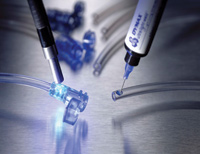
Posted to News on 25th Jun 2019, 00:00
Keeping the finishing line in sight
The Sydney Opera House turned out to be one of the most disastrous construction projects in history, running vastly over time and budget. Here Kevin Cook of Intertronics gives his top tips for ensuring a prototype can be turned into an efficiently manufactured product.

Designed by Danish architect Jorn Utzon, the construction of Australia’s most iconic monument was originally scheduled to take four years, with a budget of AUS $7 million. However, due to poor planning, it ended up taking 14 years to complete, costing a grand total of AUS $102 million. It’s easy to forget the importance of planning ahead, but doing so could save you a small fortune, and this doesn’t just apply to construction projects.
Producing a prototype is a usual practice to help ensure that the end product is functional and fit for purpose. However, if the designers haven’t considered how the prototype will be put into production, they may be forced to adapt their design further down the line. To stop this from happening, here are several concepts that the designer could consider at the start of a project where adhesives are going to be used.
Designers should consider manufacturing costs as early in a project as possible. Adhesive application is readily automatable or semi-automatable and the capital costs for this can often be easily justified. Improved quality, consistency, reduced wastage and speed, as well as potential labour savings, can make the return on investment calculation favourable.
In considering the type of adhesive to specify in the design, functionality is the primary factor – the adhesive must cure into a material capable of bearing the forces involved for the lifetime of the bonded product. But material cost is often the next consideration and here, it is important to look at the overall process. An inexpensive, albeit functional adhesive may be attractive, but if it requires significant handling or mixing, specialist application equipment or high labour input, then it may end being more expensive. For example, UV curing adhesives offer manu-facturers a fast cure, no mix process which gives efficiency and overall economy.
The understanding of eventual production quantities will have an impact on adhesive choice with respect to cure times. Ideally, the cure time will fit into production line speeds and tact times, so as not to create bottlenecks or build up large amounts of work in progress (WIP). Materials which have longer cure regimes will have to be set aside off line, taking up space and resources. Thermal cures will require some form of oven, which entails a capital outlay and ongoing energy costs – these costs are generally lower for UV curing systems, for example.
Adhesive choice is substrate dependent as adhesion to different materials will vary for each adhesive. Consequently, the selection becomes more difficult if there are multiple substrates involved. If at the design stage, substrates can be chosen which are easier to bond to, then the choice of adhesive is broader and other selection factors are able to be applied. Avoid, for example, “non-stick” PTFE and other low surface energy polymers if possible. If you are considering a light cure adhesive, then the choice of light transmitting substrates will facilitate this.
The best way to ensure that the correct adhesive is chosen for the final product is to use the same substrates in the prototyping and testing stages as will be used in production. This level of consistency will help flag up any bonding issues from the outset. Best practice is to evaluate adhesives on actual production parts.
The designer also needs to consider the environment that the product will operate in, as this will also influence adhesive choice. If it will be subject to harsh conditions, such as salt water or temperature fluctuations, the specifier needs to make sure that the adhesive, as well as the substrate, can withstand it.
Some adhesive types have process demands that need to be dealt with. Solvented adhesives will require higher levels of extraction. Moisture cure products and cyanoacrylate adhesives are dependent on relative humidity, so areas or cleanrooms which have low RH may not be a successful production environment for these types. Some room temperature vulcanising (RTV) silicones have a corrosive by-product, which makes them unsuitable for use on electronics; in these cases, a neutral cure RTV should be chosen. A bonded joint with the most optimal adhesive can be inadequate for the job if the joint design is poor. The designer should consider the types of forces involved on the structure (tensile, peel, etc) and consider how the joint will provide the right support.
As discussed earlier, the adhesive choice will have an impact on the production process, including application methods. Adhesives can be dispensed, brushed, sprayed, printed or jetted. Single part adhesives are easier to dispense and handle than two-part ones, which have to be mixed. Single part UV curing adhesives cure only when exposed to the correct wavelength and intensity of light, so the cure is “on demand”, very fast and easy to automate. If the specifier has opted for a two-part adhesive, it can be a little trickier. Two-part materials begin to gel and change in viscosity as soon as they are mixed. Often this means that a metering and mixing system will need to be employed at the point of dispense.
The specifier should be thinking about the viscosity needed to successfully apply the adhesive. Will it need to wick into a gap, bridge a gap or fill a gap? Will an adhesive bead be required or will a self-levelling product be preferred? Will it need to be dispensed onto a surface that is not horizontal and still hold its shape? Viscosity combined with dispensing technique will have to work together to overcome these challenges.
A good design for adhesives will need to have a bondline with a gap for the adhesive. This ensures a consistent adhesive thickness, which enables the adhesive to develop a sound structural bond. If the bondline is too thin, the joining parts can push the adhesive out and the bond will be poor. Achieving higher productivity and throughput will invariably lead to an automated application process. The part will need to have a bondline that is accessible to automation tools like a dispensing robot.
Forgetting to consider the adhesive from the offset may not have as drastic consequences as poor planning did for Jorn Utzon and his design of the Sydney Opera House, but following these steps will help ensure that your project runs as smoothly as possible.






